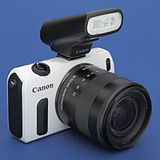At the heart of the system is the
EF lens mount, which replaced the previous
FD lens mount, which mainly supported only manual-focus lenses.
ef lens mount :
The bayonet-style EF lens mount is at the centre of the EOS camera system. Breaking compatibility with the earlier FD mount, it was designed with no mechanical linkages between moving parts in the lens and in the camera. The aperture and focus are controlled via electrical contacts, with motors in the lens itself. This was similar in some ways to Canon's earlier attempt at AF with the T80. Other manufacturers including Contax (with its G series of interchangeable-lens 35 mm rangefinder cameras), Nikon's 1983 F3AF and Olympus(with its Four Thirds System) have since embraced this type of direct drive system. It is a large lens mount compared to most of its competition, enabling the use of larger aperture lenses.
eos flash system :
The
flash system in the EOS cameras has gone through a number of evolutions since its first implementation. The basic EOS flash system was actually developed not for the first EOS camera, but rather for the last high-end
FD-mount manual-focus camera, the
T90, launched in 1986. This was the first Canon camera with
through-the-lens (TTL) flash metering, although other brands had been metering that way for some time. It also introduced the A-TTL (Advanced TTL) system for better flash exposure in program mode, using infrared preflashes to gauge subject distance.
This system was carried over into the early EOS cameras wholesale. A-TTL largely fell out of favor, and was replaced by E-TTL (Evaluative TTL). This used a pre-flash for advanced metering, and used the
autofocus system to judge where the main subject was for more accurate exposure. E-TTL II, which was an enhancement in the camera's
firmware only, replaced E-TTL from 2004.
Canon
Speedlite-brand flashes have evolved alongside the cameras. They are capable of wired and wireless multi-flash setups, the latter using visible or infrared pulses to synchronise. Canon also produces Speedlite accessories, including the OC-E3 Off-Camera Shoe Cord, which can be used to hand-hold the flash while allowing the camera to control it through the cord. The Off-Camera Shoe Cord is popular among portrait photographers who need to have more control over lighting than a camera mounted flash can offer.
eos cameras :
As of 2017, Canon has released no fewer than 70 EOS SLR and DSLR camera models, starting with the introduction of the EOS 650 in 1987. In the 1990s, Canon worked with Kodak to produce digital camera bodies, starting with the EOS DCS 3 in 1995. The first digital EOS SLR camera wholly designed and manufactured by Canon was the
EOS D30, released in 2000.
Canon also sold a manual-focus camera, the
Canon EF-M, which used the same EF lens mount as the EOS cameras. It came with all the automatic and manual exposure functions but lacked autofocus. It came equipped with a split-screen/microprism
focusing screen for precise manual focusing.
Canon EOS 650D, a Canon entry-level DSLR
Canon EOS M, Canon's first mirrorless system camera
















